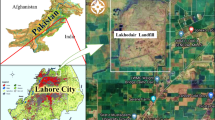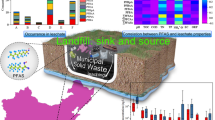Abstract
The concentrations of 41 phenols in leachates from 38 municipal solid waste (MSW) landfill sites in Japan were measured. The main phenols detected in leachates were phenol, three cresols, 4-tert-butylphenol, 4-tertoctylphenol, 4-nonylphenol, bisphenol A, and some chlorophenols. The concentration levels of phenols were affected by the pH values of the leachates and the different types of landfill waste. The origins of phenol and p-cresol were considered to be incineration residues, and the major origin of 4-tert-butylphenol, bisphenol A, and 2,4,6-trichlorophenol was considered to be solidified fly ash. In contrast, the major origins of 4-tert-octylphenol and 4-nonylphenol were considered to be incombustibles. The discharge of leachates to the environment around MSW landfill sites without water treatment facilities can cause environmental pollution by phenols. In particular, the disposal of incineration residues including solidified fly ash and the codisposal of solidified fly ash and incombustibles might raise the possibility of environmental pollution. Moreover, the discharge of leachates at pH values of 9.8 or more could pollute the water environment with phenol. However, phenol, 4-nonylphenol, and bisphenol A can be removed to below the con centration levels that impact the environment around landfill sites by a series of conventional water treatment processes.
Similar content being viewed by others
References
Yasuhara A, Shiraishi H, Nishikawa M, Yamamoto T, Uehiro T, Nakasugi O, Okumura T, Kenmotsu K, Fukui H, Nagase M, Ono Y, Kawagishi Y, Baba K, Noma Y (1997) Determination of organic components in leachates from hazardous waste disposal sites in Japan by gas chromatography-mass spectrometry. J Chromatogr A 774:321–332
Yamada K, Urase T, Matsuo T, Suzuki N (1999) Constituents of organic pollutants in leachates from different types of landfill sites and their fate in the treatment processes (in Japanese). J Jpn Soc Water Environ 22:40–45
Yasuhara A, Shiraishi H, Nishikawa M, Yamamoto T, Nakasugi O, Okumura T, Kenmotsu K, Fukui H, Nagase M, Kawagoshi Y (1999) Organic components in leachates from hazardous waste disposal sites. Waste Manage Res 17:186–197
Shiraishi H, Nakasugi O, Hashimoto S, Yamamoto T, Yasuhara A, Yasuda K (1999) Endocrine disrupters in the leachate from waste disposal sites (in Japanese). J Jpn Soc Waste Manag Experts 10:293–305
Yamamoto T, Yasuhara A, Shiraishi H, Nakasugi O (2001) Bisphenol A in hazardous waste landfill leachates. Chemosphere 42: 415–418
Namegaya Y, Suzuki S, Yasuhara A, Mohri S, Yamada M, Inoue Y (2002) Concentrations of inorganic components; 1,4-dioxane; phenols; and phthalates in leachates from waste landfills and their treated waters (in Japanese). J Environ Chem 12:817–827
Urase T, Miyashita K (2003) Factors affecting the concentration of bisphenol A in leachates from solid waste disposal sites and its fate in treatment processes. J Mater Cycles Waste Manag 5:77–82
Asakura H, Matsuto T, Tanaka N (2004) Behavior of endocrinedisrupting chemicals in leachates from MSW landfill sites in Japan. Waste Manag 24:613–622
Sakamoto H, Fukui H, Souta I, Kaneko H (2004) Studies on bisphenol A and its origins in leachates from solid waste landfills (in Japanese). J Jpn Soc Waste Manag Experts 15:511–520
Ministry of the Environment of Japan (2005) Perspectives on endocrine disrupting effects of substances — ExTEND 2005
International Agency for Research on Cancer. Complete list of agents evaluated and their classification: http://monographs.iarc.fr/ENG/Classification/index.php (Access date: January 4, 2007)
Kurata Y (1994) Determination of phenols in water by direct acetylation (in Japanese). J Environ Chem 4:55–64
Japanese Standard Association (2002) Testing method for alkyl phenols in industrial water and wastewater, JIS K 0450-20-10 appendix 1(in Japanese), Tokyo
The Ministry of the Environment of Japan (2002) Document No. 5 for the 2002 First Commission on Endocrine Disrupting Effects of Substances (in Japanese). http://www.env.go.jp/chemi/end/kento1401/ (Access date: January 4, 2007)
The Ministry of the Environment of Japan (2001) Document No. 2 for the 2001 First Commission on Endocrine Disrupting Effects of Substances (in Japanese). http://www.env.go.jp/chemi/end/kento1301/index.html (Access date: January 4, 2007)
The Ministry of the Environment of Japan (2004) Document No. 5-2 for the 2004 First Commission on Endocrine Disrupting Effects of Substances (in Japanese). http://www.env.go.jp/chemi/end/kento1601/ (Access date: January 4, 2007)
Author information
Authors and Affiliations
Corresponding author
Rights and permissions
About this article
Cite this article
Kurata, Y., Ono, Y. & Ono, Y. Occurrence of phenols in leachates from municipal solid waste landfill sites in Japan. J Mater Cycles Waste Manag 10, 144–152 (2008). https://doi.org/10.1007/s10163-008-0200-x
Received:
Accepted:
Published:
Issue Date:
DOI: https://doi.org/10.1007/s10163-008-0200-x




